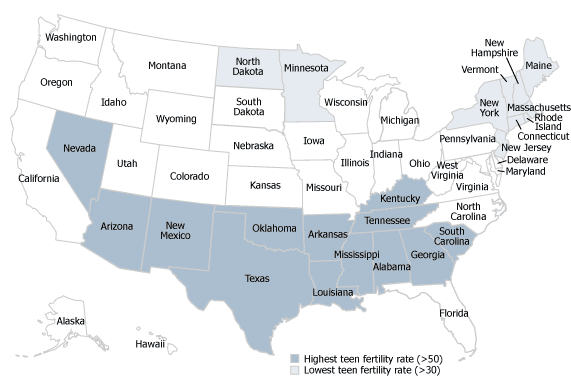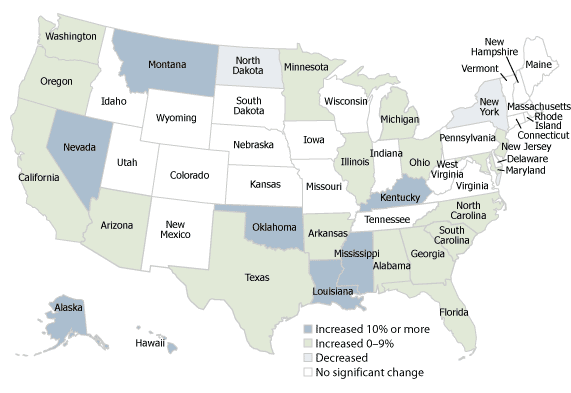
Rising U.S. Teen Fertility
Date
February 10, 2009
Author
(February 2009) The United States has higher fertility rates among teenage girls compared with other developed countries of the world.1 For example, girls ages 15 to 19 have fertility rates more than five times higher than their counterparts in developed countries such as France, Italy, Japan, Slovenia, and Switzerland.
Nonetheless, the fertility rate of girls ages 15 to 19 declined consecutively over the period from 1991 to 2005.2 During this time, the fertility rate of the age group dropped by one-third, from 61.8 births per 1,000 girls ages 15 to 19 in 1991 to 40.5 in 2005. However, the latest data for 2006 may point to a reversal of this trend, with the fertility rate inching upward to 41.9.3
This trend is of great concern because adolescent pregnancy has been associated with unemployment, poverty, repeated pregnancy, sexually transmitted diseases, infant mortality, high risk pregnancy, and lower educational achievement.4 Furthermore, teenage pregnancy is a primary indicator of adult poverty among women.5
Figure 1
Highest and Lowest Teenage Fertility Rates per 1,000 Girls Ages 15-19, 2006

Source: U.S. Centers for Disease Control and Prevention, National Center for Health Statistics.
Racial and Ethnic Variations in Teen Fertility
There are significant variations in the teen fertility rate across racial and ethnic groups. For example, Asian and other Pacific Islander females ages 15 to 19 have the lowest fertility rate (17 births per 1,000 girls), followed by non-Hispanic white girls (26.6). In contrast, Latina girls ages 15 to 19 have fertility rates that are three times higher than those of non-Hispanic whites. The fertility rates of American Indian or Alaska Native and non-Hispanic black girls are more than twice as high as that of white girls.
However, the fertility rates of girls ages 15 to 19 increased uniformly across racial and ethnic groups between 2005 and 2006, with the exception of Asian and other Pacific Islanders whose fertility rate remained unchanged at 17.
State Variations in Teen Fertility
The fertility rate among girls ages 15 to 19 varies tremendously from a low of 18.7 in New Hampshire to a high of 68.4 in Mississippi. There is a clear regional split between states with the highest and lowest teenage fertility rates (see Figure 1). For example, the 13 states with teenage fertility rates above 50 are located primarily in the South (10 states) with a few in the West (three states). In contrast, the 10 states with teenage fertility rates below 30 per 1,000 are located mainly in the Northeast (eight states) with the other two in the Midwest.
The rising teenage fertility trend between 2005 and 2006 is fairly widespread. In fact, 26 states experienced significant increases in the fertility rates of girls ages 15 to 19 during this period (see Figure 2). Nearly half of these states are in the South (12 states) while nearly one-third are in the West (eight states), one-fifth in the Midwest (five states), and one additional state in the Northeast (New Jersey).
Eight states experienced increases of 10 percent or greater in their teenage fertility rates between 2005 and 2006: Alaska (19 percent), Mississippi (13 percent), Montana (13 percent), Hawaii (12 percent), Kentucky (11 percent), Nevada (11 percent), Louisiana (10 percent), and Oklahoma (10 percent).
In contrast, only three states and the District of Columbia experienced significant drops in their teenage fertility rates: District of Columbia (-24 percent), North Dakota (-11 percent), Rhode Island (-11 percent), and New York (-3 percent).
Figure 2
Trends in Teenage Fertility Rates for Girls Ages 15-19, 2005-2006

Source: Joyce A. Martin et al., “Births: Final Data for 2006,” National Vital Statistics Reports 57, no. 7 (Hyattsville, MD: National Center for Health Statistics, 2009).
Implications
The United States continues to have the highest teenage fertility rate in the developed world. Recent data may point to a disturbing reversal of the decline in the teenage fertility rate of the United States that had been apace over the 14-year period from 1991 to 2005.
Policymakers and educators need to monitor this trend to ensure that young girls do not become entrapped in a cycle of poverty that frequently accompanies early childbearing. Educational and career programs designed to create alternatives to youthful marriage and motherhood are valuable in reversing this trend, as are sex education courses to teach youth about contraception and reproductive health.
Rogelio Saenz is professor of sociology at Texas A&M University. Eugenia Conde is a doctoral student in the Department of Sociology at Texas A&M University.
References
- United Nations, World Fertility Patterns 2007, accessed online at www.un.org/esa/population/publications/worldfertility2007/worldfertility2007.htm, on Feb. 2, 2009.
- The fertility rate of girls ages 15 to 19 refers to the number of births per 1,000 girls ages 15 to 19. This rate is used in the report to represent the teenage fertility rate.
- Data for the analysis and for Figure 2 in this article come from Joyce A. Martin et al., “Births: Final Data for 2006,” National Vital Statistics Reports 57, no. 7 (Hyattsville, MD: National Center for Health Statistics, 2009).
- Rebekah Levine Coley and P. Lindsay Chase-Lansdale, “Adolescent Pregnancy and Parenthood: Recent Evidence and Future Directions,” American Psychologist 53, no. 2 (1998): 152-66; and Christina S. Meade and Jeannette R. Ickovics, “Systemic Review of Sexual Risk Among Pregnant and Mothering Teens in the USA: Pregnancy as an Opportunity for Integrated Prevention of STD and Repeated Pregnancy,” Social Science and Medicine 60, no. 4 (2005): 661-78.
- John Hobcraft and Kathleen Kiernan, “Childhood Poverty, Early Motherhood, and Adult Social Exclusion,” The British Journal of Sociology 52, no. 3 (2001): 495-517; and May Luong, “Life After Teenage Motherhood,” Perspectives on Labour and Income 20, no. 5 (2008): 41-49.
